BP Deepwater Horizon Oil Spill and Offshore Drilling
VerifiedAdded on 2023/06/12
|12
|3201
|104
AI Summary
This essay analyzes the BP Deepwater Horizon Oil Spill and Offshore Drilling incident in 2010, highlighting the lack of systems thinking, risk management, and organizational behavior. It suggests tools and techniques for systems thinking, portfolio management, and risk management to avoid such incidents in the future.
Contribute Materials
Your contribution can guide someone’s learning journey. Share your
documents today.
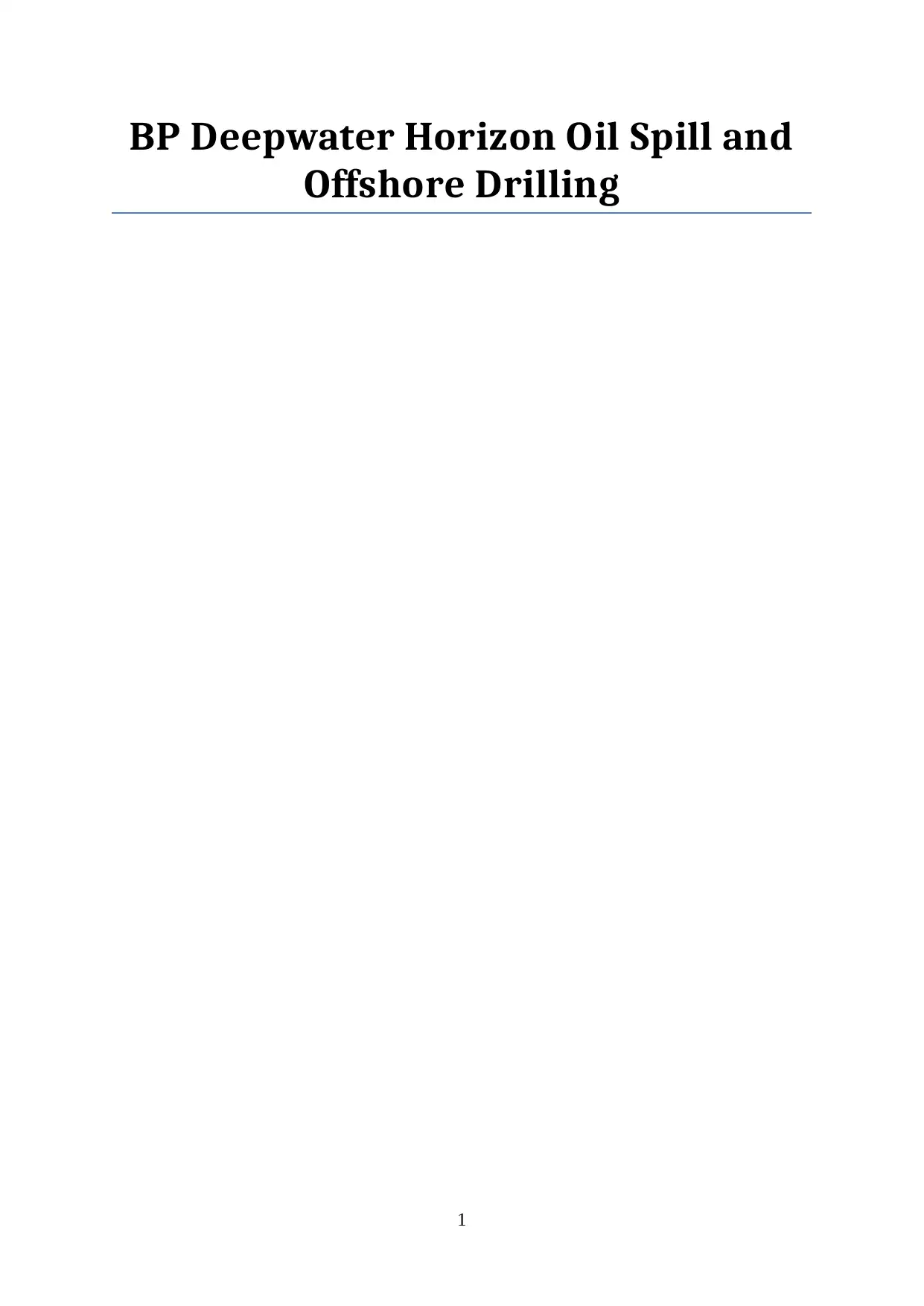
BP Deepwater Horizon Oil Spill and
Offshore Drilling
1
Offshore Drilling
1
Secure Best Marks with AI Grader
Need help grading? Try our AI Grader for instant feedback on your assignments.
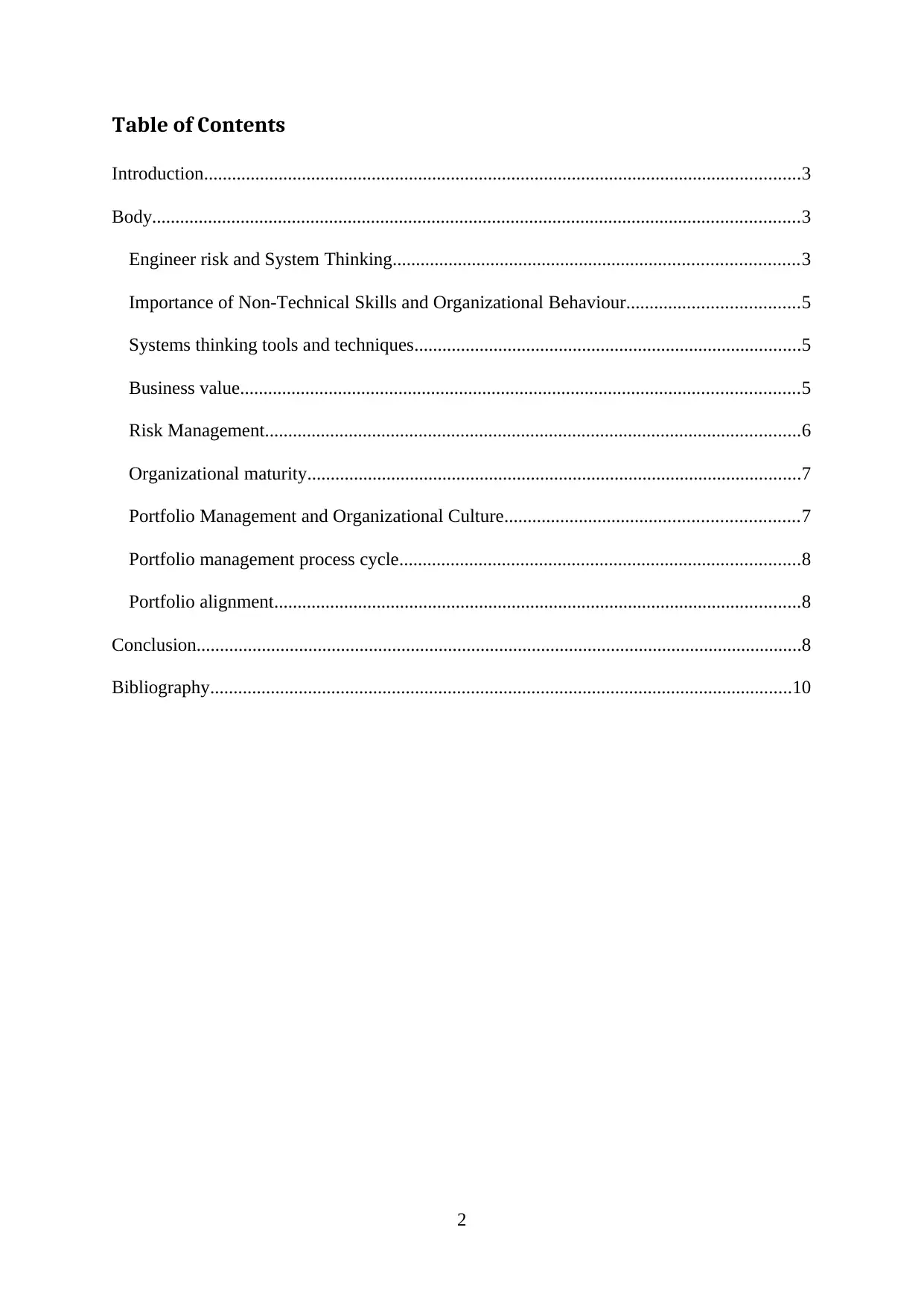
Table of Contents
Introduction................................................................................................................................3
Body...........................................................................................................................................3
Engineer risk and System Thinking.......................................................................................3
Importance of Non-Technical Skills and Organizational Behaviour.....................................5
Systems thinking tools and techniques...................................................................................5
Business value........................................................................................................................5
Risk Management...................................................................................................................6
Organizational maturity..........................................................................................................7
Portfolio Management and Organizational Culture...............................................................7
Portfolio management process cycle......................................................................................8
Portfolio alignment.................................................................................................................8
Conclusion..................................................................................................................................8
Bibliography.............................................................................................................................10
2
Introduction................................................................................................................................3
Body...........................................................................................................................................3
Engineer risk and System Thinking.......................................................................................3
Importance of Non-Technical Skills and Organizational Behaviour.....................................5
Systems thinking tools and techniques...................................................................................5
Business value........................................................................................................................5
Risk Management...................................................................................................................6
Organizational maturity..........................................................................................................7
Portfolio Management and Organizational Culture...............................................................7
Portfolio management process cycle......................................................................................8
Portfolio alignment.................................................................................................................8
Conclusion..................................................................................................................................8
Bibliography.............................................................................................................................10
2
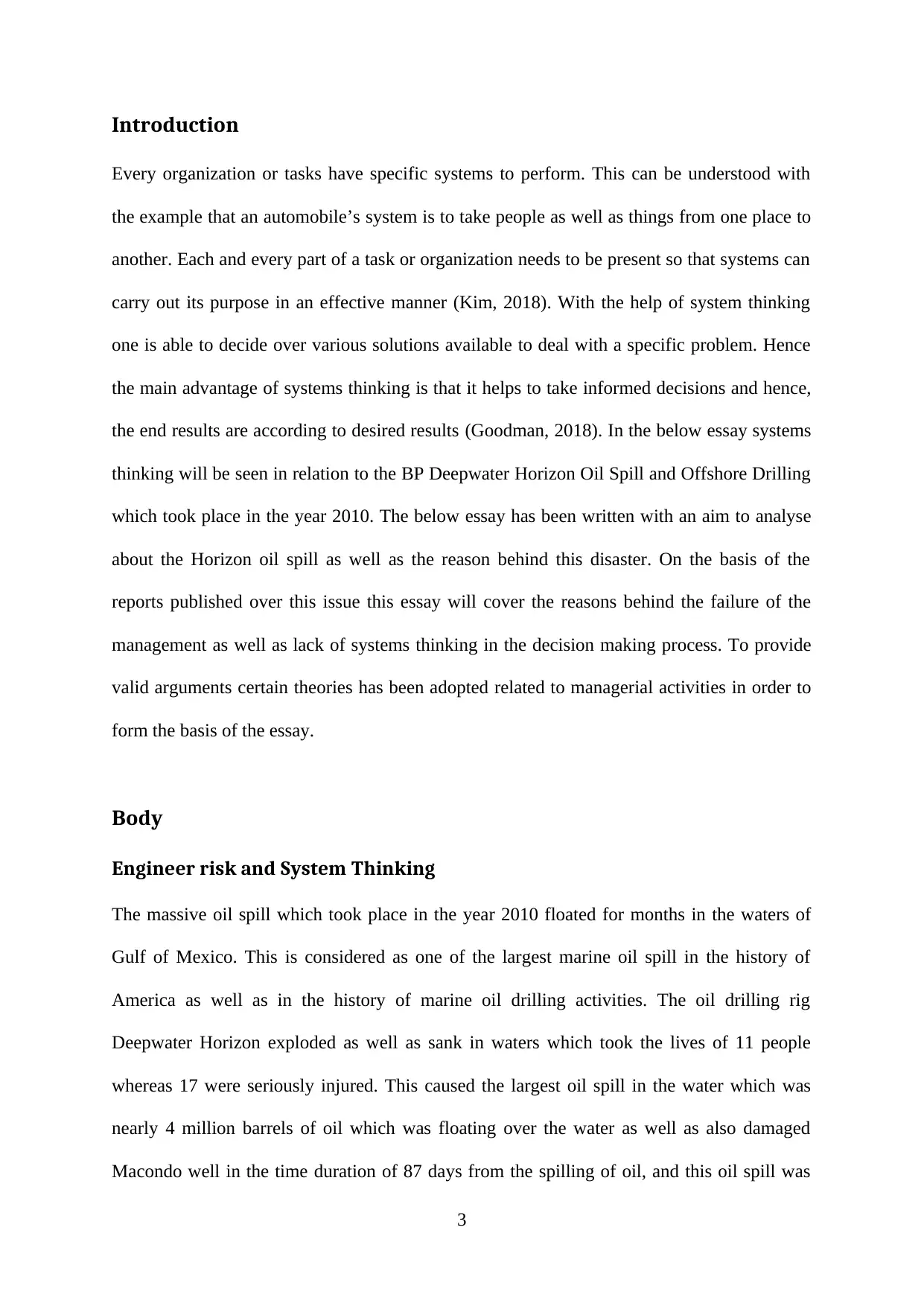
Introduction
Every organization or tasks have specific systems to perform. This can be understood with
the example that an automobile’s system is to take people as well as things from one place to
another. Each and every part of a task or organization needs to be present so that systems can
carry out its purpose in an effective manner (Kim, 2018). With the help of system thinking
one is able to decide over various solutions available to deal with a specific problem. Hence
the main advantage of systems thinking is that it helps to take informed decisions and hence,
the end results are according to desired results (Goodman, 2018). In the below essay systems
thinking will be seen in relation to the BP Deepwater Horizon Oil Spill and Offshore Drilling
which took place in the year 2010. The below essay has been written with an aim to analyse
about the Horizon oil spill as well as the reason behind this disaster. On the basis of the
reports published over this issue this essay will cover the reasons behind the failure of the
management as well as lack of systems thinking in the decision making process. To provide
valid arguments certain theories has been adopted related to managerial activities in order to
form the basis of the essay.
Body
Engineer risk and System Thinking
The massive oil spill which took place in the year 2010 floated for months in the waters of
Gulf of Mexico. This is considered as one of the largest marine oil spill in the history of
America as well as in the history of marine oil drilling activities. The oil drilling rig
Deepwater Horizon exploded as well as sank in waters which took the lives of 11 people
whereas 17 were seriously injured. This caused the largest oil spill in the water which was
nearly 4 million barrels of oil which was floating over the water as well as also damaged
Macondo well in the time duration of 87 days from the spilling of oil, and this oil spill was
3
Every organization or tasks have specific systems to perform. This can be understood with
the example that an automobile’s system is to take people as well as things from one place to
another. Each and every part of a task or organization needs to be present so that systems can
carry out its purpose in an effective manner (Kim, 2018). With the help of system thinking
one is able to decide over various solutions available to deal with a specific problem. Hence
the main advantage of systems thinking is that it helps to take informed decisions and hence,
the end results are according to desired results (Goodman, 2018). In the below essay systems
thinking will be seen in relation to the BP Deepwater Horizon Oil Spill and Offshore Drilling
which took place in the year 2010. The below essay has been written with an aim to analyse
about the Horizon oil spill as well as the reason behind this disaster. On the basis of the
reports published over this issue this essay will cover the reasons behind the failure of the
management as well as lack of systems thinking in the decision making process. To provide
valid arguments certain theories has been adopted related to managerial activities in order to
form the basis of the essay.
Body
Engineer risk and System Thinking
The massive oil spill which took place in the year 2010 floated for months in the waters of
Gulf of Mexico. This is considered as one of the largest marine oil spill in the history of
America as well as in the history of marine oil drilling activities. The oil drilling rig
Deepwater Horizon exploded as well as sank in waters which took the lives of 11 people
whereas 17 were seriously injured. This caused the largest oil spill in the water which was
nearly 4 million barrels of oil which was floating over the water as well as also damaged
Macondo well in the time duration of 87 days from the spilling of oil, and this oil spill was
3
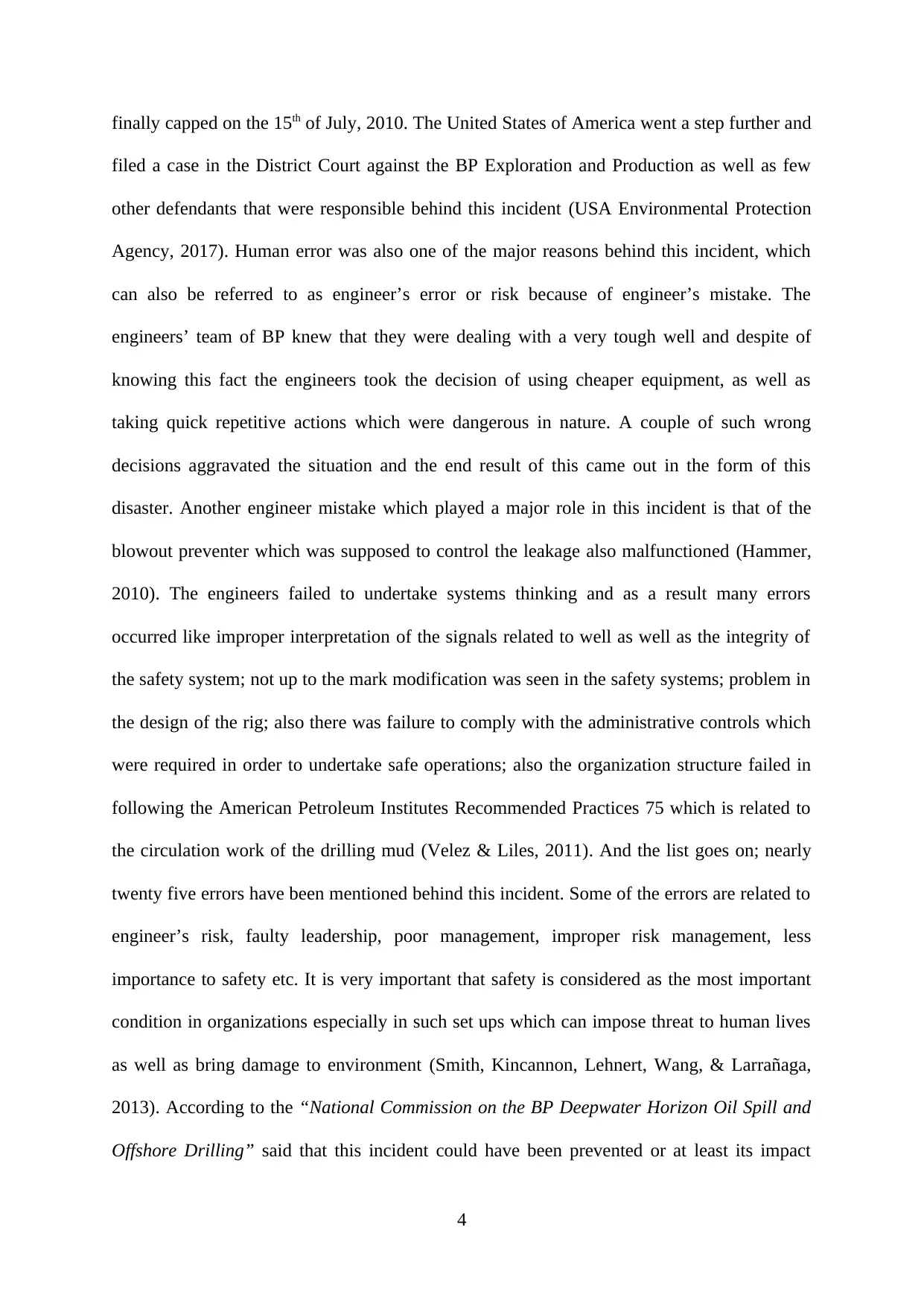
finally capped on the 15th of July, 2010. The United States of America went a step further and
filed a case in the District Court against the BP Exploration and Production as well as few
other defendants that were responsible behind this incident (USA Environmental Protection
Agency, 2017). Human error was also one of the major reasons behind this incident, which
can also be referred to as engineer’s error or risk because of engineer’s mistake. The
engineers’ team of BP knew that they were dealing with a very tough well and despite of
knowing this fact the engineers took the decision of using cheaper equipment, as well as
taking quick repetitive actions which were dangerous in nature. A couple of such wrong
decisions aggravated the situation and the end result of this came out in the form of this
disaster. Another engineer mistake which played a major role in this incident is that of the
blowout preventer which was supposed to control the leakage also malfunctioned (Hammer,
2010). The engineers failed to undertake systems thinking and as a result many errors
occurred like improper interpretation of the signals related to well as well as the integrity of
the safety system; not up to the mark modification was seen in the safety systems; problem in
the design of the rig; also there was failure to comply with the administrative controls which
were required in order to undertake safe operations; also the organization structure failed in
following the American Petroleum Institutes Recommended Practices 75 which is related to
the circulation work of the drilling mud (Velez & Liles, 2011). And the list goes on; nearly
twenty five errors have been mentioned behind this incident. Some of the errors are related to
engineer’s risk, faulty leadership, poor management, improper risk management, less
importance to safety etc. It is very important that safety is considered as the most important
condition in organizations especially in such set ups which can impose threat to human lives
as well as bring damage to environment (Smith, Kincannon, Lehnert, Wang, & Larrañaga,
2013). According to the “National Commission on the BP Deepwater Horizon Oil Spill and
Offshore Drilling” said that this incident could have been prevented or at least its impact
4
filed a case in the District Court against the BP Exploration and Production as well as few
other defendants that were responsible behind this incident (USA Environmental Protection
Agency, 2017). Human error was also one of the major reasons behind this incident, which
can also be referred to as engineer’s error or risk because of engineer’s mistake. The
engineers’ team of BP knew that they were dealing with a very tough well and despite of
knowing this fact the engineers took the decision of using cheaper equipment, as well as
taking quick repetitive actions which were dangerous in nature. A couple of such wrong
decisions aggravated the situation and the end result of this came out in the form of this
disaster. Another engineer mistake which played a major role in this incident is that of the
blowout preventer which was supposed to control the leakage also malfunctioned (Hammer,
2010). The engineers failed to undertake systems thinking and as a result many errors
occurred like improper interpretation of the signals related to well as well as the integrity of
the safety system; not up to the mark modification was seen in the safety systems; problem in
the design of the rig; also there was failure to comply with the administrative controls which
were required in order to undertake safe operations; also the organization structure failed in
following the American Petroleum Institutes Recommended Practices 75 which is related to
the circulation work of the drilling mud (Velez & Liles, 2011). And the list goes on; nearly
twenty five errors have been mentioned behind this incident. Some of the errors are related to
engineer’s risk, faulty leadership, poor management, improper risk management, less
importance to safety etc. It is very important that safety is considered as the most important
condition in organizations especially in such set ups which can impose threat to human lives
as well as bring damage to environment (Smith, Kincannon, Lehnert, Wang, & Larrañaga,
2013). According to the “National Commission on the BP Deepwater Horizon Oil Spill and
Offshore Drilling” said that this incident could have been prevented or at least its impact
4
Secure Best Marks with AI Grader
Need help grading? Try our AI Grader for instant feedback on your assignments.
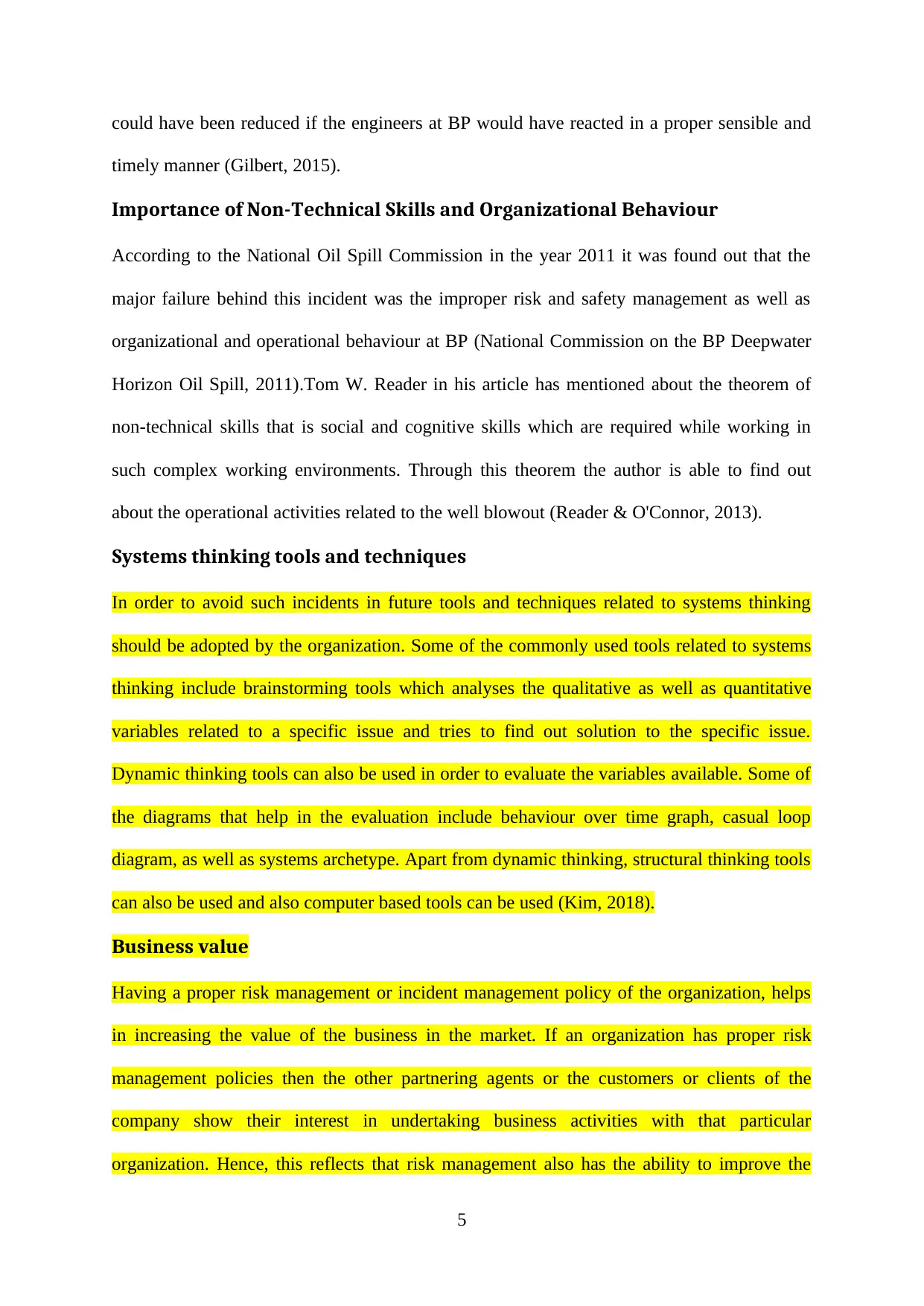
could have been reduced if the engineers at BP would have reacted in a proper sensible and
timely manner (Gilbert, 2015).
Importance of Non-Technical Skills and Organizational Behaviour
According to the National Oil Spill Commission in the year 2011 it was found out that the
major failure behind this incident was the improper risk and safety management as well as
organizational and operational behaviour at BP (National Commission on the BP Deepwater
Horizon Oil Spill, 2011).Tom W. Reader in his article has mentioned about the theorem of
non-technical skills that is social and cognitive skills which are required while working in
such complex working environments. Through this theorem the author is able to find out
about the operational activities related to the well blowout (Reader & O'Connor, 2013).
Systems thinking tools and techniques
In order to avoid such incidents in future tools and techniques related to systems thinking
should be adopted by the organization. Some of the commonly used tools related to systems
thinking include brainstorming tools which analyses the qualitative as well as quantitative
variables related to a specific issue and tries to find out solution to the specific issue.
Dynamic thinking tools can also be used in order to evaluate the variables available. Some of
the diagrams that help in the evaluation include behaviour over time graph, casual loop
diagram, as well as systems archetype. Apart from dynamic thinking, structural thinking tools
can also be used and also computer based tools can be used (Kim, 2018).
Business value
Having a proper risk management or incident management policy of the organization, helps
in increasing the value of the business in the market. If an organization has proper risk
management policies then the other partnering agents or the customers or clients of the
company show their interest in undertaking business activities with that particular
organization. Hence, this reflects that risk management also has the ability to improve the
5
timely manner (Gilbert, 2015).
Importance of Non-Technical Skills and Organizational Behaviour
According to the National Oil Spill Commission in the year 2011 it was found out that the
major failure behind this incident was the improper risk and safety management as well as
organizational and operational behaviour at BP (National Commission on the BP Deepwater
Horizon Oil Spill, 2011).Tom W. Reader in his article has mentioned about the theorem of
non-technical skills that is social and cognitive skills which are required while working in
such complex working environments. Through this theorem the author is able to find out
about the operational activities related to the well blowout (Reader & O'Connor, 2013).
Systems thinking tools and techniques
In order to avoid such incidents in future tools and techniques related to systems thinking
should be adopted by the organization. Some of the commonly used tools related to systems
thinking include brainstorming tools which analyses the qualitative as well as quantitative
variables related to a specific issue and tries to find out solution to the specific issue.
Dynamic thinking tools can also be used in order to evaluate the variables available. Some of
the diagrams that help in the evaluation include behaviour over time graph, casual loop
diagram, as well as systems archetype. Apart from dynamic thinking, structural thinking tools
can also be used and also computer based tools can be used (Kim, 2018).
Business value
Having a proper risk management or incident management policy of the organization, helps
in increasing the value of the business in the market. If an organization has proper risk
management policies then the other partnering agents or the customers or clients of the
company show their interest in undertaking business activities with that particular
organization. Hence, this reflects that risk management also has the ability to improve the
5

business value of an organization (Ruth, 2018). In this case it can be clearly said that because
of this incident the business value of Deepwater Horizon is reduced not only in intangible
terms but also in monetary terms. The year this incident took place BP suffered a loss of
$16.973 billion because of the costs associated with the accident (Jones, 2011). Also the
organization lost 55% of the shareholder value of the organization soon after the Deepwater
Horizon incident took place. So this reflects that incidents may negatively impact the
business value of an organization (Chamberlin, 2014).
Risk Management
Risk management of BP Deepwater Horizon was no doubt inadequate hence there is a need
to adopt resilience based design instead of risk management in order to tackle the situations
more quickly and smartly. The main benefit of this concept is that it provides with the
ecological analogues related to diverse situations as well as also suggests ways of adoption of
methods in order to deal with high consequence disruptions that can be caused because of
drilling activities (Park, Seager, & Rao, 2011). Risk management starts after the identification
of the hazard which may prove to be problematic if any unknown hazard takes place
(Normile, 2011). Resilience based management suggests with options to deal with
unexpected and unidentified hazards with the help of the adaption as well as experimentation
and innovation along with diversity (Klein, Nicholls, & Thomalla, 2003).
Jon Espen Skogdalen and others in their article has discussed about the indicators that should
be given importance in Risk Level projects (RNNP). On the basis of the analysis of the BP
Deepwater Horizon the authors have suggested few extensions to the indicators related to the
RNNP (Skogdalen, Utne, & Vinnem, 2011). It is very important to include the Human and
Organizational Factors (HOF) as well as Risk Influence Factors (RIF) like the working
practices, communication as well as management activities. The Quantitative Risk Analysis
(QRA) of the projects is required to include RIFs as well as HOFs so that a proper analysis
6
of this incident the business value of Deepwater Horizon is reduced not only in intangible
terms but also in monetary terms. The year this incident took place BP suffered a loss of
$16.973 billion because of the costs associated with the accident (Jones, 2011). Also the
organization lost 55% of the shareholder value of the organization soon after the Deepwater
Horizon incident took place. So this reflects that incidents may negatively impact the
business value of an organization (Chamberlin, 2014).
Risk Management
Risk management of BP Deepwater Horizon was no doubt inadequate hence there is a need
to adopt resilience based design instead of risk management in order to tackle the situations
more quickly and smartly. The main benefit of this concept is that it provides with the
ecological analogues related to diverse situations as well as also suggests ways of adoption of
methods in order to deal with high consequence disruptions that can be caused because of
drilling activities (Park, Seager, & Rao, 2011). Risk management starts after the identification
of the hazard which may prove to be problematic if any unknown hazard takes place
(Normile, 2011). Resilience based management suggests with options to deal with
unexpected and unidentified hazards with the help of the adaption as well as experimentation
and innovation along with diversity (Klein, Nicholls, & Thomalla, 2003).
Jon Espen Skogdalen and others in their article has discussed about the indicators that should
be given importance in Risk Level projects (RNNP). On the basis of the analysis of the BP
Deepwater Horizon the authors have suggested few extensions to the indicators related to the
RNNP (Skogdalen, Utne, & Vinnem, 2011). It is very important to include the Human and
Organizational Factors (HOF) as well as Risk Influence Factors (RIF) like the working
practices, communication as well as management activities. The Quantitative Risk Analysis
(QRA) of the projects is required to include RIFs as well as HOFs so that a proper analysis
6
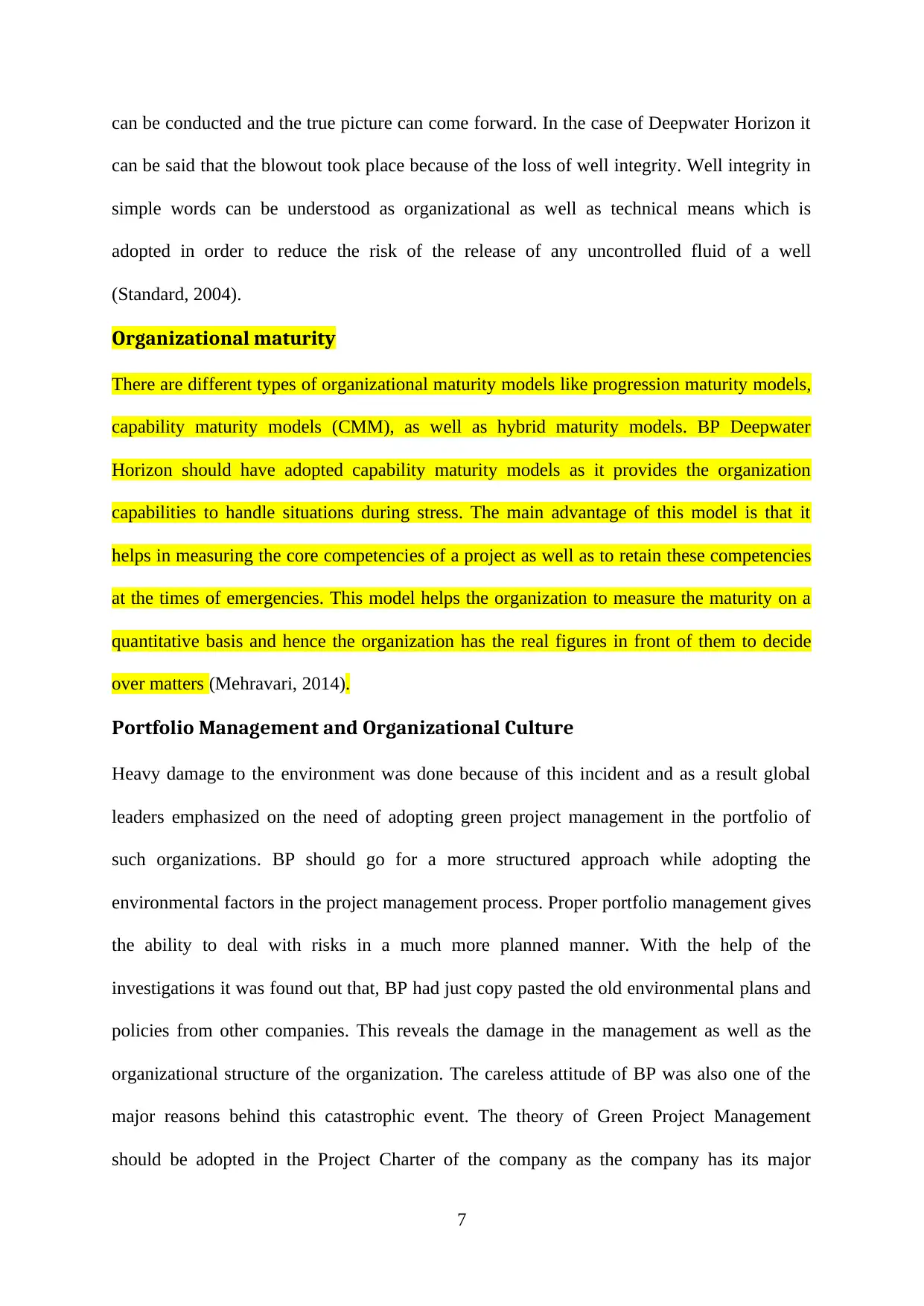
can be conducted and the true picture can come forward. In the case of Deepwater Horizon it
can be said that the blowout took place because of the loss of well integrity. Well integrity in
simple words can be understood as organizational as well as technical means which is
adopted in order to reduce the risk of the release of any uncontrolled fluid of a well
(Standard, 2004).
Organizational maturity
There are different types of organizational maturity models like progression maturity models,
capability maturity models (CMM), as well as hybrid maturity models. BP Deepwater
Horizon should have adopted capability maturity models as it provides the organization
capabilities to handle situations during stress. The main advantage of this model is that it
helps in measuring the core competencies of a project as well as to retain these competencies
at the times of emergencies. This model helps the organization to measure the maturity on a
quantitative basis and hence the organization has the real figures in front of them to decide
over matters (Mehravari, 2014).
Portfolio Management and Organizational Culture
Heavy damage to the environment was done because of this incident and as a result global
leaders emphasized on the need of adopting green project management in the portfolio of
such organizations. BP should go for a more structured approach while adopting the
environmental factors in the project management process. Proper portfolio management gives
the ability to deal with risks in a much more planned manner. With the help of the
investigations it was found out that, BP had just copy pasted the old environmental plans and
policies from other companies. This reveals the damage in the management as well as the
organizational structure of the organization. The careless attitude of BP was also one of the
major reasons behind this catastrophic event. The theory of Green Project Management
should be adopted in the Project Charter of the company as the company has its major
7
can be said that the blowout took place because of the loss of well integrity. Well integrity in
simple words can be understood as organizational as well as technical means which is
adopted in order to reduce the risk of the release of any uncontrolled fluid of a well
(Standard, 2004).
Organizational maturity
There are different types of organizational maturity models like progression maturity models,
capability maturity models (CMM), as well as hybrid maturity models. BP Deepwater
Horizon should have adopted capability maturity models as it provides the organization
capabilities to handle situations during stress. The main advantage of this model is that it
helps in measuring the core competencies of a project as well as to retain these competencies
at the times of emergencies. This model helps the organization to measure the maturity on a
quantitative basis and hence the organization has the real figures in front of them to decide
over matters (Mehravari, 2014).
Portfolio Management and Organizational Culture
Heavy damage to the environment was done because of this incident and as a result global
leaders emphasized on the need of adopting green project management in the portfolio of
such organizations. BP should go for a more structured approach while adopting the
environmental factors in the project management process. Proper portfolio management gives
the ability to deal with risks in a much more planned manner. With the help of the
investigations it was found out that, BP had just copy pasted the old environmental plans and
policies from other companies. This reveals the damage in the management as well as the
organizational structure of the organization. The careless attitude of BP was also one of the
major reasons behind this catastrophic event. The theory of Green Project Management
should be adopted in the Project Charter of the company as the company has its major
7
Paraphrase This Document
Need a fresh take? Get an instant paraphrase of this document with our AI Paraphraser
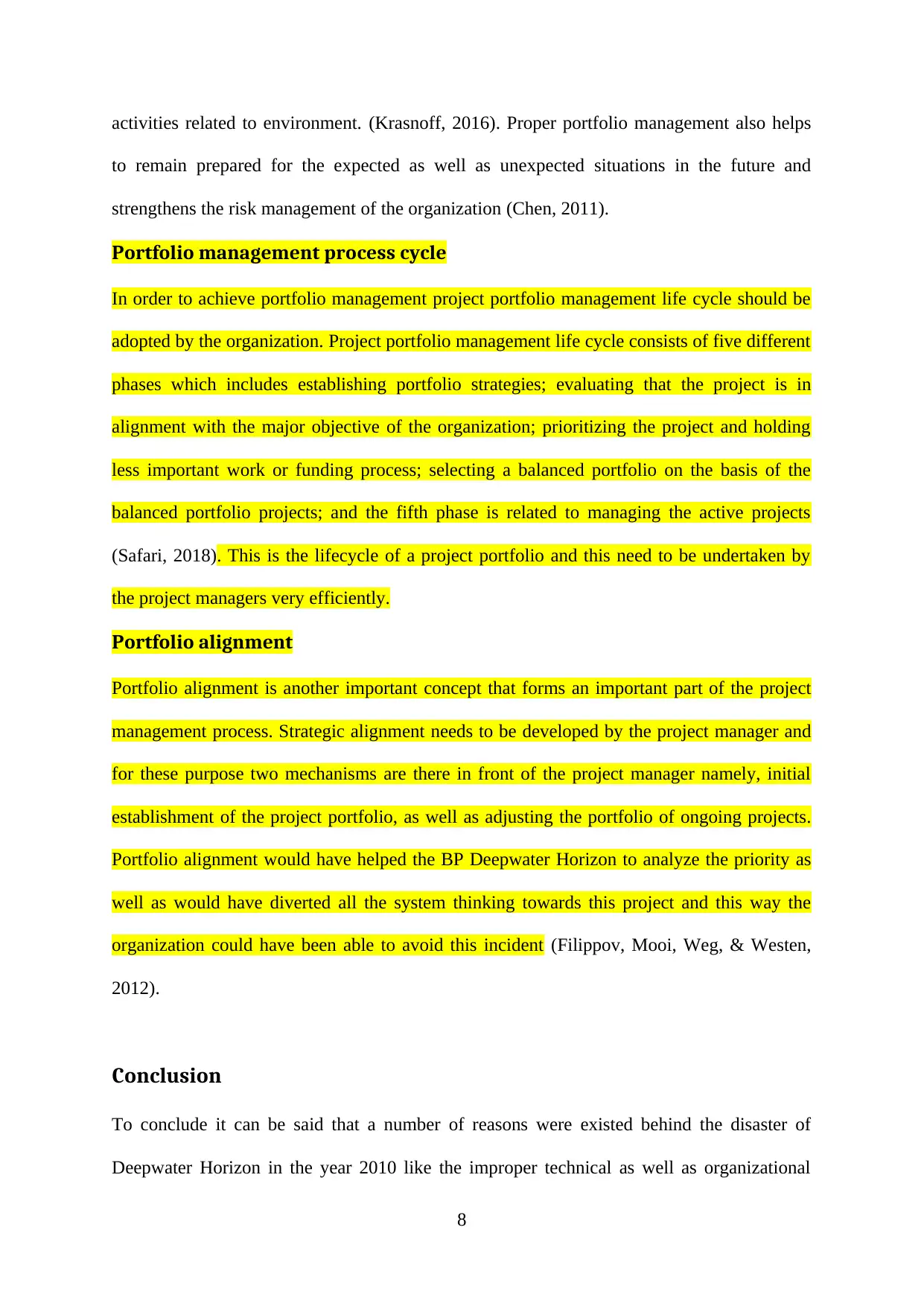
activities related to environment. (Krasnoff, 2016). Proper portfolio management also helps
to remain prepared for the expected as well as unexpected situations in the future and
strengthens the risk management of the organization (Chen, 2011).
Portfolio management process cycle
In order to achieve portfolio management project portfolio management life cycle should be
adopted by the organization. Project portfolio management life cycle consists of five different
phases which includes establishing portfolio strategies; evaluating that the project is in
alignment with the major objective of the organization; prioritizing the project and holding
less important work or funding process; selecting a balanced portfolio on the basis of the
balanced portfolio projects; and the fifth phase is related to managing the active projects
(Safari, 2018). This is the lifecycle of a project portfolio and this need to be undertaken by
the project managers very efficiently.
Portfolio alignment
Portfolio alignment is another important concept that forms an important part of the project
management process. Strategic alignment needs to be developed by the project manager and
for these purpose two mechanisms are there in front of the project manager namely, initial
establishment of the project portfolio, as well as adjusting the portfolio of ongoing projects.
Portfolio alignment would have helped the BP Deepwater Horizon to analyze the priority as
well as would have diverted all the system thinking towards this project and this way the
organization could have been able to avoid this incident (Filippov, Mooi, Weg, & Westen,
2012).
Conclusion
To conclude it can be said that a number of reasons were existed behind the disaster of
Deepwater Horizon in the year 2010 like the improper technical as well as organizational
8
to remain prepared for the expected as well as unexpected situations in the future and
strengthens the risk management of the organization (Chen, 2011).
Portfolio management process cycle
In order to achieve portfolio management project portfolio management life cycle should be
adopted by the organization. Project portfolio management life cycle consists of five different
phases which includes establishing portfolio strategies; evaluating that the project is in
alignment with the major objective of the organization; prioritizing the project and holding
less important work or funding process; selecting a balanced portfolio on the basis of the
balanced portfolio projects; and the fifth phase is related to managing the active projects
(Safari, 2018). This is the lifecycle of a project portfolio and this need to be undertaken by
the project managers very efficiently.
Portfolio alignment
Portfolio alignment is another important concept that forms an important part of the project
management process. Strategic alignment needs to be developed by the project manager and
for these purpose two mechanisms are there in front of the project manager namely, initial
establishment of the project portfolio, as well as adjusting the portfolio of ongoing projects.
Portfolio alignment would have helped the BP Deepwater Horizon to analyze the priority as
well as would have diverted all the system thinking towards this project and this way the
organization could have been able to avoid this incident (Filippov, Mooi, Weg, & Westen,
2012).
Conclusion
To conclude it can be said that a number of reasons were existed behind the disaster of
Deepwater Horizon in the year 2010 like the improper technical as well as organizational
8
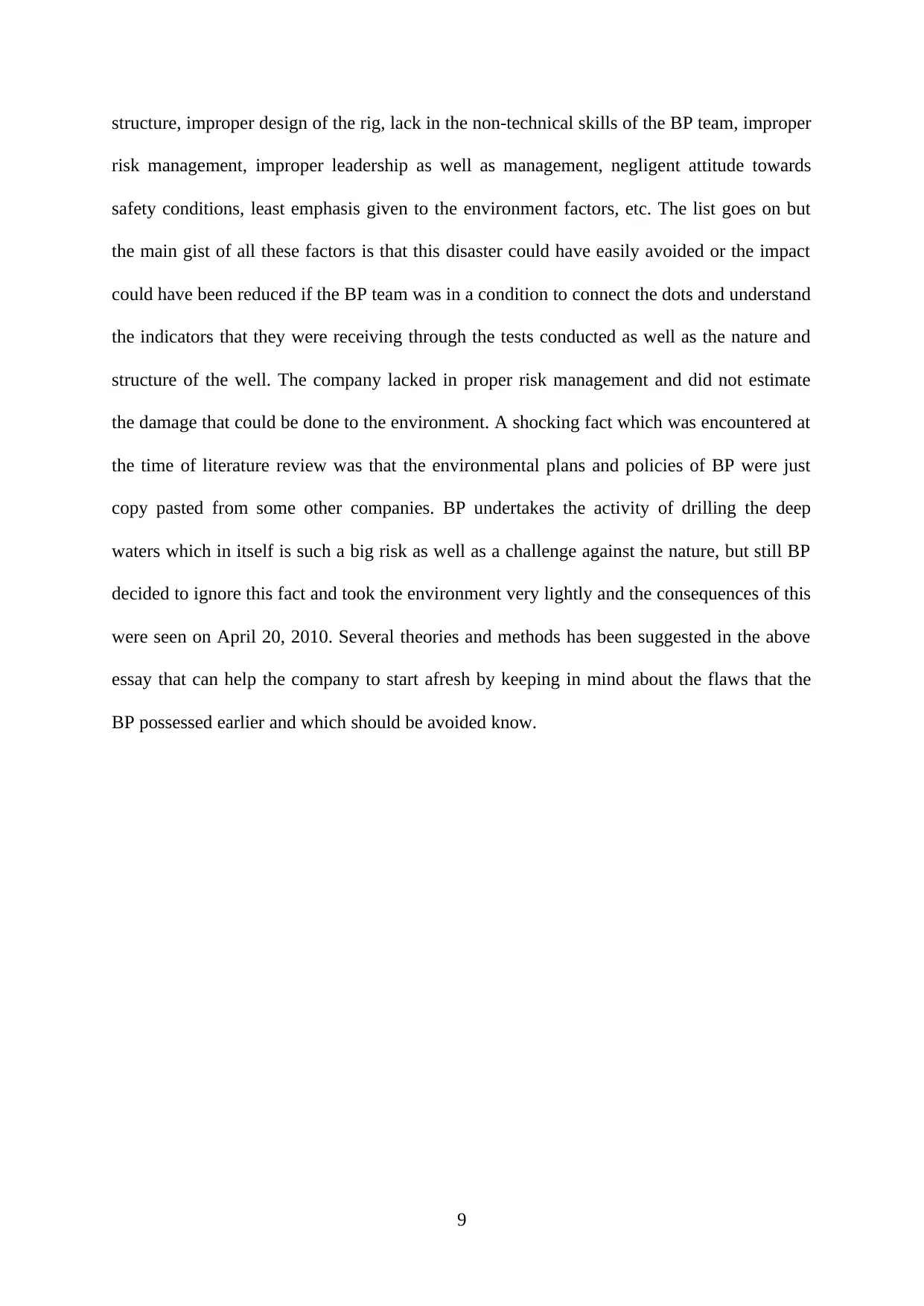
structure, improper design of the rig, lack in the non-technical skills of the BP team, improper
risk management, improper leadership as well as management, negligent attitude towards
safety conditions, least emphasis given to the environment factors, etc. The list goes on but
the main gist of all these factors is that this disaster could have easily avoided or the impact
could have been reduced if the BP team was in a condition to connect the dots and understand
the indicators that they were receiving through the tests conducted as well as the nature and
structure of the well. The company lacked in proper risk management and did not estimate
the damage that could be done to the environment. A shocking fact which was encountered at
the time of literature review was that the environmental plans and policies of BP were just
copy pasted from some other companies. BP undertakes the activity of drilling the deep
waters which in itself is such a big risk as well as a challenge against the nature, but still BP
decided to ignore this fact and took the environment very lightly and the consequences of this
were seen on April 20, 2010. Several theories and methods has been suggested in the above
essay that can help the company to start afresh by keeping in mind about the flaws that the
BP possessed earlier and which should be avoided know.
9
risk management, improper leadership as well as management, negligent attitude towards
safety conditions, least emphasis given to the environment factors, etc. The list goes on but
the main gist of all these factors is that this disaster could have easily avoided or the impact
could have been reduced if the BP team was in a condition to connect the dots and understand
the indicators that they were receiving through the tests conducted as well as the nature and
structure of the well. The company lacked in proper risk management and did not estimate
the damage that could be done to the environment. A shocking fact which was encountered at
the time of literature review was that the environmental plans and policies of BP were just
copy pasted from some other companies. BP undertakes the activity of drilling the deep
waters which in itself is such a big risk as well as a challenge against the nature, but still BP
decided to ignore this fact and took the environment very lightly and the consequences of this
were seen on April 20, 2010. Several theories and methods has been suggested in the above
essay that can help the company to start afresh by keeping in mind about the flaws that the
BP possessed earlier and which should be avoided know.
9
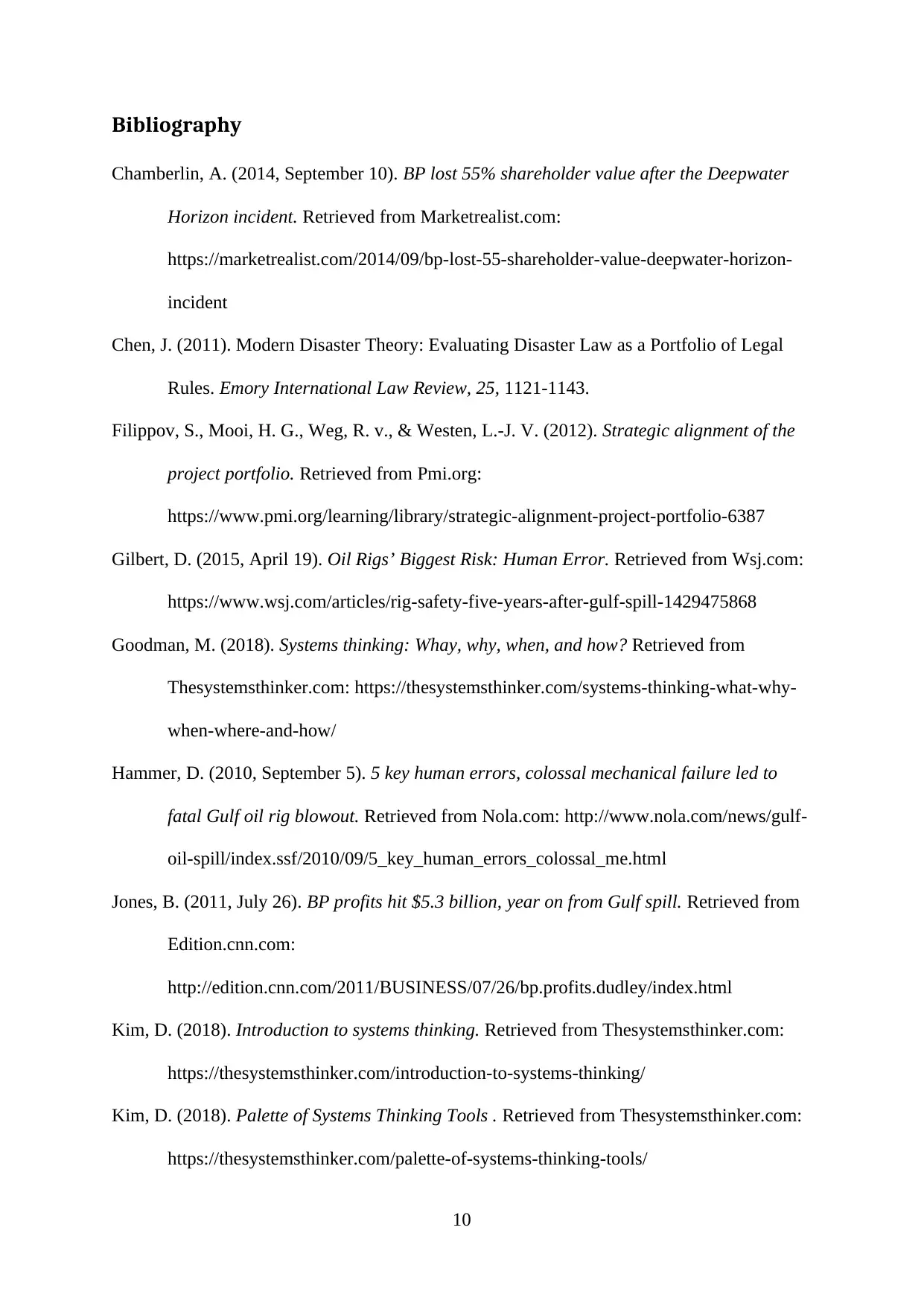
Bibliography
Chamberlin, A. (2014, September 10). BP lost 55% shareholder value after the Deepwater
Horizon incident. Retrieved from Marketrealist.com:
https://marketrealist.com/2014/09/bp-lost-55-shareholder-value-deepwater-horizon-
incident
Chen, J. (2011). Modern Disaster Theory: Evaluating Disaster Law as a Portfolio of Legal
Rules. Emory International Law Review, 25, 1121-1143.
Filippov, S., Mooi, H. G., Weg, R. v., & Westen, L.-J. V. (2012). Strategic alignment of the
project portfolio. Retrieved from Pmi.org:
https://www.pmi.org/learning/library/strategic-alignment-project-portfolio-6387
Gilbert, D. (2015, April 19). Oil Rigs’ Biggest Risk: Human Error. Retrieved from Wsj.com:
https://www.wsj.com/articles/rig-safety-five-years-after-gulf-spill-1429475868
Goodman, M. (2018). Systems thinking: Whay, why, when, and how? Retrieved from
Thesystemsthinker.com: https://thesystemsthinker.com/systems-thinking-what-why-
when-where-and-how/
Hammer, D. (2010, September 5). 5 key human errors, colossal mechanical failure led to
fatal Gulf oil rig blowout. Retrieved from Nola.com: http://www.nola.com/news/gulf-
oil-spill/index.ssf/2010/09/5_key_human_errors_colossal_me.html
Jones, B. (2011, July 26). BP profits hit $5.3 billion, year on from Gulf spill. Retrieved from
Edition.cnn.com:
http://edition.cnn.com/2011/BUSINESS/07/26/bp.profits.dudley/index.html
Kim, D. (2018). Introduction to systems thinking. Retrieved from Thesystemsthinker.com:
https://thesystemsthinker.com/introduction-to-systems-thinking/
Kim, D. (2018). Palette of Systems Thinking Tools . Retrieved from Thesystemsthinker.com:
https://thesystemsthinker.com/palette-of-systems-thinking-tools/
10
Chamberlin, A. (2014, September 10). BP lost 55% shareholder value after the Deepwater
Horizon incident. Retrieved from Marketrealist.com:
https://marketrealist.com/2014/09/bp-lost-55-shareholder-value-deepwater-horizon-
incident
Chen, J. (2011). Modern Disaster Theory: Evaluating Disaster Law as a Portfolio of Legal
Rules. Emory International Law Review, 25, 1121-1143.
Filippov, S., Mooi, H. G., Weg, R. v., & Westen, L.-J. V. (2012). Strategic alignment of the
project portfolio. Retrieved from Pmi.org:
https://www.pmi.org/learning/library/strategic-alignment-project-portfolio-6387
Gilbert, D. (2015, April 19). Oil Rigs’ Biggest Risk: Human Error. Retrieved from Wsj.com:
https://www.wsj.com/articles/rig-safety-five-years-after-gulf-spill-1429475868
Goodman, M. (2018). Systems thinking: Whay, why, when, and how? Retrieved from
Thesystemsthinker.com: https://thesystemsthinker.com/systems-thinking-what-why-
when-where-and-how/
Hammer, D. (2010, September 5). 5 key human errors, colossal mechanical failure led to
fatal Gulf oil rig blowout. Retrieved from Nola.com: http://www.nola.com/news/gulf-
oil-spill/index.ssf/2010/09/5_key_human_errors_colossal_me.html
Jones, B. (2011, July 26). BP profits hit $5.3 billion, year on from Gulf spill. Retrieved from
Edition.cnn.com:
http://edition.cnn.com/2011/BUSINESS/07/26/bp.profits.dudley/index.html
Kim, D. (2018). Introduction to systems thinking. Retrieved from Thesystemsthinker.com:
https://thesystemsthinker.com/introduction-to-systems-thinking/
Kim, D. (2018). Palette of Systems Thinking Tools . Retrieved from Thesystemsthinker.com:
https://thesystemsthinker.com/palette-of-systems-thinking-tools/
10
Secure Best Marks with AI Grader
Need help grading? Try our AI Grader for instant feedback on your assignments.

Klein, R. J., Nicholls, R. J., & Thomalla, F. (2003). Resilience to natural hazards: How useful
is this concept? Global Environmental Change Part B: Environmental Hazards, 5(1-
2), 35-45.
Krasnoff, A. (2016). Green Project Management and the BP Deepwater Horizon Spill.
Retrieved from Greeneconomypost.com/: http://greeneconomypost.com/green-
project-management-bp-deepwater-horizon-spill-11455.htm
Mehravari, D. N. (2014). Everything You Always Wanted to Know About Maturity Models.
Retrieved from Resources.sei.cmu.edu:
https://resources.sei.cmu.edu/asset_files/Webinar/2014_018_101_293863.pdf
National Commission on the BP Deepwater Horizon Oil Spill. (2011). Deepwater The Gulf
Oil Disaster and teh Future of Offshore Drilling. Retrieved from Gpo.gov:
https://www.gpo.gov/fdsys/pkg/GPO-OILCOMMISSION/pdf/GPO-
OILCOMMISSION.pdf
Normile, D. (2011). Devastating Earthquake Defied Expectations. Science.
Park, J., Seager, T. P., & Rao, P. S. (2011). Lessons in risk‐ versus resilience‐based design
and management. Integrated Environmental Assessment and Management, 7(3), 396-
399.
Reader, T. W., & O'Connor, P. (2013). The Deepwater Horizon explosion: non-technical
skills, safety culture, and system complexity. Journal of Risk Research, 17(3), 405-
424.
Ruth, E. (2018, February 19). How does incident management add value to your business?
Retrieved from Proprofs.com: https://www.proprofs.com/discuss/q/424468/36-
incident-management-has-value-to-the-business-by
Safari. (2018). The Project Portfolio Management Life Cycle. Retrieved from
Safaribooksonline.com: https://www.safaribooksonline.com/library/view/effective-
11
is this concept? Global Environmental Change Part B: Environmental Hazards, 5(1-
2), 35-45.
Krasnoff, A. (2016). Green Project Management and the BP Deepwater Horizon Spill.
Retrieved from Greeneconomypost.com/: http://greeneconomypost.com/green-
project-management-bp-deepwater-horizon-spill-11455.htm
Mehravari, D. N. (2014). Everything You Always Wanted to Know About Maturity Models.
Retrieved from Resources.sei.cmu.edu:
https://resources.sei.cmu.edu/asset_files/Webinar/2014_018_101_293863.pdf
National Commission on the BP Deepwater Horizon Oil Spill. (2011). Deepwater The Gulf
Oil Disaster and teh Future of Offshore Drilling. Retrieved from Gpo.gov:
https://www.gpo.gov/fdsys/pkg/GPO-OILCOMMISSION/pdf/GPO-
OILCOMMISSION.pdf
Normile, D. (2011). Devastating Earthquake Defied Expectations. Science.
Park, J., Seager, T. P., & Rao, P. S. (2011). Lessons in risk‐ versus resilience‐based design
and management. Integrated Environmental Assessment and Management, 7(3), 396-
399.
Reader, T. W., & O'Connor, P. (2013). The Deepwater Horizon explosion: non-technical
skills, safety culture, and system complexity. Journal of Risk Research, 17(3), 405-
424.
Ruth, E. (2018, February 19). How does incident management add value to your business?
Retrieved from Proprofs.com: https://www.proprofs.com/discuss/q/424468/36-
incident-management-has-value-to-the-business-by
Safari. (2018). The Project Portfolio Management Life Cycle. Retrieved from
Safaribooksonline.com: https://www.safaribooksonline.com/library/view/effective-
11
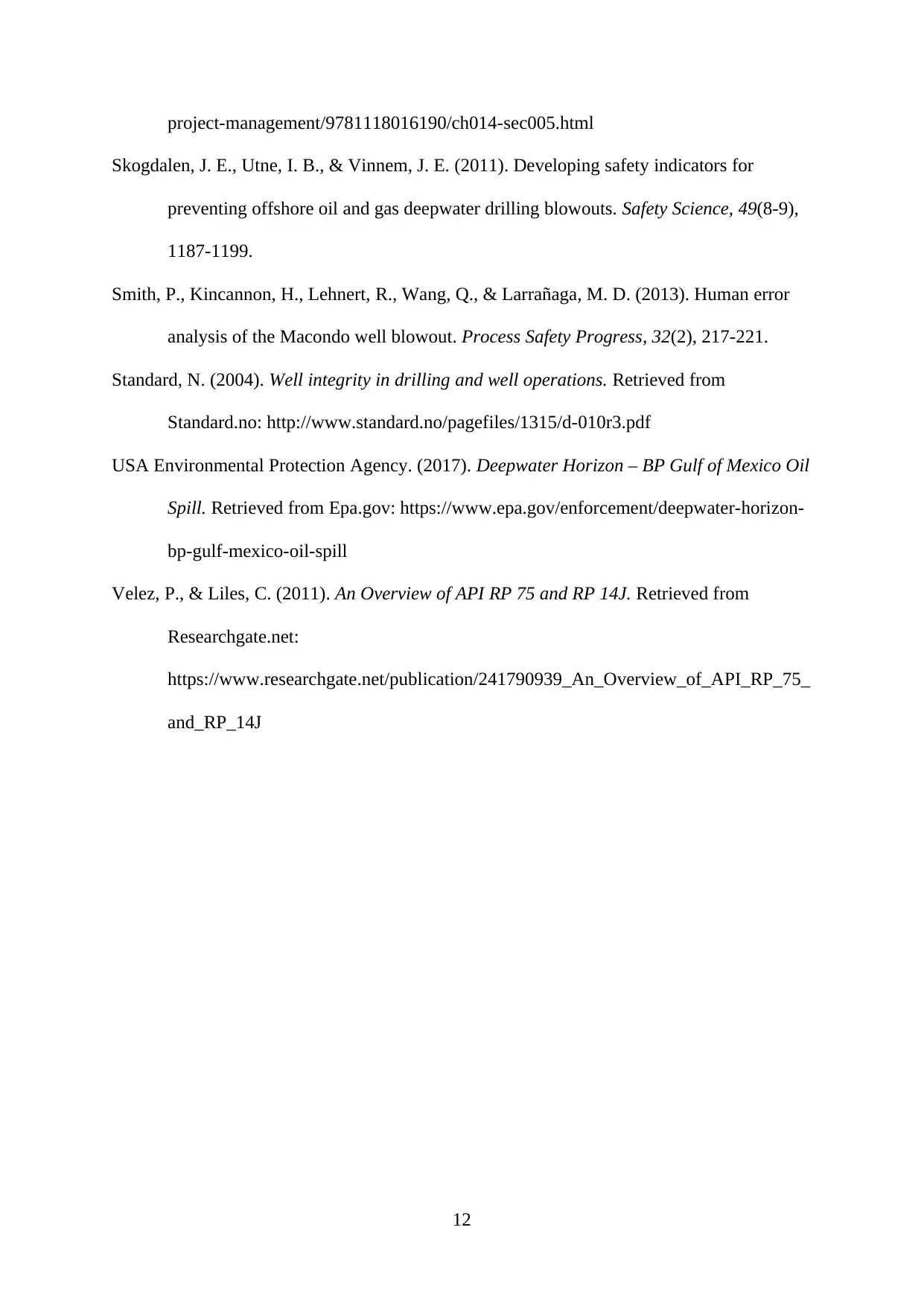
project-management/9781118016190/ch014-sec005.html
Skogdalen, J. E., Utne, I. B., & Vinnem, J. E. (2011). Developing safety indicators for
preventing offshore oil and gas deepwater drilling blowouts. Safety Science, 49(8-9),
1187-1199.
Smith, P., Kincannon, H., Lehnert, R., Wang, Q., & Larrañaga, M. D. (2013). Human error
analysis of the Macondo well blowout. Process Safety Progress, 32(2), 217-221.
Standard, N. (2004). Well integrity in drilling and well operations. Retrieved from
Standard.no: http://www.standard.no/pagefiles/1315/d-010r3.pdf
USA Environmental Protection Agency. (2017). Deepwater Horizon – BP Gulf of Mexico Oil
Spill. Retrieved from Epa.gov: https://www.epa.gov/enforcement/deepwater-horizon-
bp-gulf-mexico-oil-spill
Velez, P., & Liles, C. (2011). An Overview of API RP 75 and RP 14J. Retrieved from
Researchgate.net:
https://www.researchgate.net/publication/241790939_An_Overview_of_API_RP_75_
and_RP_14J
12
Skogdalen, J. E., Utne, I. B., & Vinnem, J. E. (2011). Developing safety indicators for
preventing offshore oil and gas deepwater drilling blowouts. Safety Science, 49(8-9),
1187-1199.
Smith, P., Kincannon, H., Lehnert, R., Wang, Q., & Larrañaga, M. D. (2013). Human error
analysis of the Macondo well blowout. Process Safety Progress, 32(2), 217-221.
Standard, N. (2004). Well integrity in drilling and well operations. Retrieved from
Standard.no: http://www.standard.no/pagefiles/1315/d-010r3.pdf
USA Environmental Protection Agency. (2017). Deepwater Horizon – BP Gulf of Mexico Oil
Spill. Retrieved from Epa.gov: https://www.epa.gov/enforcement/deepwater-horizon-
bp-gulf-mexico-oil-spill
Velez, P., & Liles, C. (2011). An Overview of API RP 75 and RP 14J. Retrieved from
Researchgate.net:
https://www.researchgate.net/publication/241790939_An_Overview_of_API_RP_75_
and_RP_14J
12
1 out of 12
Related Documents
Your All-in-One AI-Powered Toolkit for Academic Success.
+13062052269
info@desklib.com
Available 24*7 on WhatsApp / Email
![[object Object]](/_next/static/media/star-bottom.7253800d.svg)
Unlock your academic potential
© 2024 | Zucol Services PVT LTD | All rights reserved.





